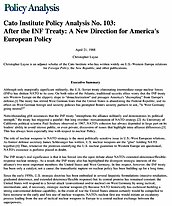Notwithstanding glib assurances that the INF treaty “strengthens the alliance militarily and demonstrates its political strength,” the treaty has triggered a painful–but long overdue–reexamination of NATO strategy.[2] As University of California political scientist Paul Seabury observed in 1967, NATO’s cohesion has always depended in large part on its leaders’ ability to avoid intense public, or even private, discussion of issues that highlight intra-alliance differences.[3] This has always been especially true with respect to nuclear Policy.
The role of nuclear weapons in NATO strategy is the most politically sensitive issue in U.S.-West European relations. As former defense secretary James Schlesinger has written, U.S. nuclear weapons are the “glue” holding NATO together.[4] Thus, whenever the premises underlying the U.S. nuclear guarantee to Western Europe are questioned, NATO’s existence is perforce placed in doubt.
The INF treaty’s real significance is that it has forced into the open debate about NATO’s extended-deterrence/flexible-response nuclear strategy. As a result, the INF treaty also has highlighted the divergent strategic interests of the alliance’s two most important members: the United States and West Germany. In this respect, however, the INF treaty has been only a catalyst, not a cause; the transatlantic rupture on nuclear policy has been building up for a long time.
Since the early 1950s, U.S. strategic doctrine has been embodied in several linguistic formulations (massive retaliation, graduated deterrence, and extended deterrence/flexible response) but its central premise has remained constant: the United States will respond to a Soviet attack (conventional and/or nuclear) on West Germany by using tactical, intermediate, and, if necessary, strategic nuclear weapons.[5] Because NATO historically has eschewed building a strong conventional defense capability, in the event of war the United States almost certainly would be compelled to have recourse to the early and first use of nuclear weapons. NATO’s nuclear first use would initiate an escalatory process leading from the use of tactical nuclear weapons in Europe to a central nuclear exchange between the superpowers.


